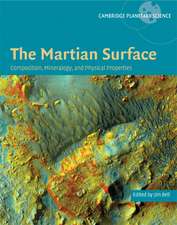The Twin Sister Planets Venus and Earth: Why are they so different?
Autor Robert J. Malcuiten Limba Engleză Paperback – 10 sep 2016
| Toate formatele și edițiile | Preț | Express |
|---|---|---|
| Paperback (1) | 646.62 lei 6-8 săpt. | |
| Springer International Publishing – 10 sep 2016 | 646.62 lei 6-8 săpt. | |
| Hardback (1) | 653.00 lei 6-8 săpt. | |
| Springer International Publishing – 10 dec 2014 | 653.00 lei 6-8 săpt. |
Preț: 646.62 lei
Preț vechi: 760.73 lei
-15% Nou
Puncte Express: 970
Preț estimativ în valută:
123.77€ • 134.49$ • 104.03£
123.77€ • 134.49$ • 104.03£
Carte tipărită la comandă
Livrare economică 21 aprilie-05 mai
Preluare comenzi: 021 569.72.76
Specificații
ISBN-13: 9783319345031
ISBN-10: 3319345036
Pagini: 420
Ilustrații: XIX, 401 p. 225 illus., 68 illus. in color.
Dimensiuni: 155 x 235 x 22 mm
Greutate: 0.59 kg
Ediția:Softcover reprint of the original 1st ed. 2015
Editura: Springer International Publishing
Colecția Springer
Locul publicării:Cham, Switzerland
ISBN-10: 3319345036
Pagini: 420
Ilustrații: XIX, 401 p. 225 illus., 68 illus. in color.
Dimensiuni: 155 x 235 x 22 mm
Greutate: 0.59 kg
Ediția:Softcover reprint of the original 1st ed. 2015
Editura: Springer International Publishing
Colecția Springer
Locul publicării:Cham, Switzerland
Cuprins
Introduction.- The Origin of the Sun and the Early Evolution of the Solar System.- Models for the Origin and Evolution of the Earth-Moon System.- A Prograde Gravitational Capture Model for the Origin and Evolution of the Earth-Moon System.- Some Critical Interpretations and Misinterpretations of Lunar Features.- Origin and Evolution of the Venus-Adonis System: A Retrograde Gravitational Capture Model.- A Retrograde Gravitational Capture Model for the Earth-Moon System.- Planet Orbit – Lunar Orbit Resonances and the History of the Earth-Moon System.- Discussion of the Probability of Finding Habitable Planets for Humans Orbiting Sun-Like Stars.- Summary and Conclusions.- Appendices.- Glossary.- Index.
Recenzii
“The book presents a highly detailed discussion ofthe idea, which has clearly been a long-term research interest of the author. …The book will therefore be very interesting to specialists in the field, and itcontains a wealth of detail, diagrams, many examples of computer simulations,and many references. … The detailed Glossary will be helpful for thenon-specialist reader.” (Richard McKim, The Observatory, Vol. 136 (1250),February, 2016)
Notă biografică
Bob Malcuit received his Bachelor and Master degrees in Geology from Kent State University in 1968 and 1970 and his Ph.D. in Geology from Michigan State University in 1973. He taught in the Geosciences Department at Denison University from 1972 to 1999. His main research interests throughout his teaching career and in retirement are in the field of Planetary Geology.
Textul de pe ultima copertă
This book explains how it came to be that Venus and Earth, while very similar in chemical composition, zonation, size and heliocentric distance from the Sun, are very different in surface environmental conditions. It is argued here that these differences can be accounted for by planetoid capture processes and the subsequent evolution of the planet-satellite system. Venus captured a one-half moon-mass planetoid early in its history in the retrograde direction and underwent its “fatal attraction scenario” with its satellite (Adonis). Earth, on the other hand, captured a moon-mass planetoid (Luna) early in its history in prograde orbit and underwent a benign estrangement scenario with its captured satellite.
Caracteristici
A comprehensive model for the evolution the planet Earth and Venus over Geologic Time Offers a new approach to the intact capture model Contains proposed tests of the models presented Has many significant implications for the argument that habitable planets may be fairly rare in a large region of space Includes supplementary material: sn.pub/extras











